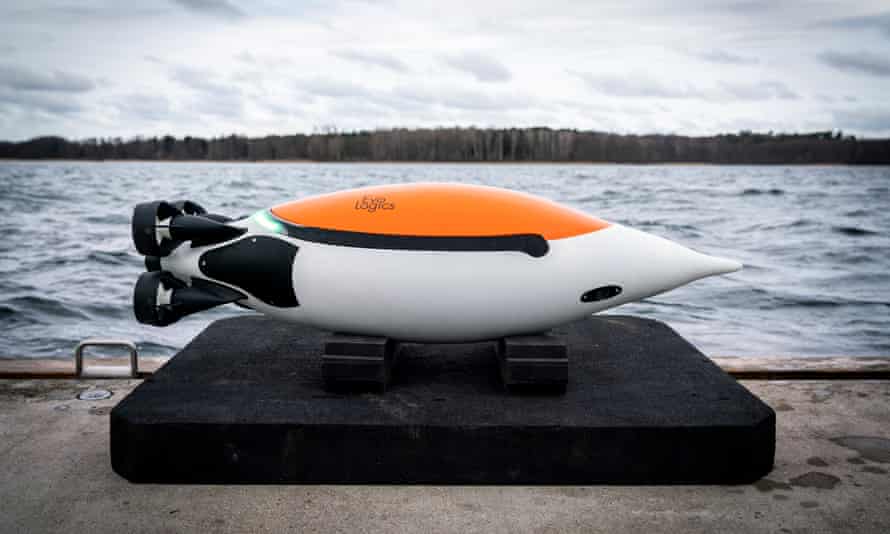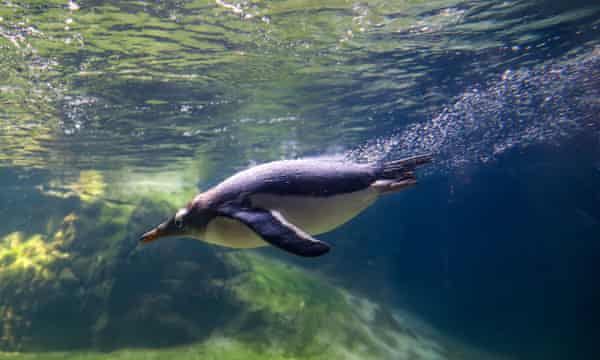 Researchers hope to use artificial intelligence to allow the robot penguins, named Quadroins, to interact with each other.
Researchers hope to use artificial intelligence to allow the robot penguins, named Quadroins, to interact with each other.Photograph: Hereon/Florian Büttner
From The Guardian by Florian Sturm
They can go on
research missions in stormy weather, dive to 150 metres and could soon
be ‘singing’ signals.
These penguin-like devices are helping to explain the eddies that are key to all life
If it looks like a penguin and swims like a penguin – but it’s actually a robot – then it must be the latest advance in marine sensory equipment.
The Quadroin is an autonomous underwater vehicle (AUV): a 3D-printed self-propelled machine designed to mimic a penguin in order to measure the properties of oceanic eddies.
It was developed by Burkard Baschek while head of Germany’s Institute of Coastal Ocean Dynamics at the Helmholtz Centre Hereon in Geesthacht after he watched more than $20,000 of his equipment sink to the bottom of the Pacific Ocean.
These penguin-like devices are helping to explain the eddies that are key to all life
If it looks like a penguin and swims like a penguin – but it’s actually a robot – then it must be the latest advance in marine sensory equipment.
The Quadroin is an autonomous underwater vehicle (AUV): a 3D-printed self-propelled machine designed to mimic a penguin in order to measure the properties of oceanic eddies.
It was developed by Burkard Baschek while head of Germany’s Institute of Coastal Ocean Dynamics at the Helmholtz Centre Hereon in Geesthacht after he watched more than $20,000 of his equipment sink to the bottom of the Pacific Ocean.

A Nasa image of the eddies and small currents just below the ocean’s surface, showing the swirling pattern of phytoplankton blooms in the southern Atlantic Ocean.
Photograph: Nasa/Zuma/ Rex/Shutterstock
Photograph: Nasa/Zuma/ Rex/Shutterstock
Eddies are small ocean currents that other research methods have struggled to capture.
They influence all the animals and plants in the seas as well as the Earth’s climate, driving roughly 50% of all phytoplankton production.
The base of the marine food chain, phytoplankton and other marine plants such as kelp and algal plankton also produce up to 70% of atmospheric oxygen.
“Every fourth breath each human takes depends on those small ocean eddies,” says Baschek, who is now director of the German Oceanographic Museum in the northern port of Stralsund.
Despite their significance, eddies are poorly understood within the scientific community because they are small; some are just 10 metres across, and they have an average lifespan of 12 hours, posing a huge challenge for ocean observations.
Few detailed measurements even exist.
Baschek first developed an array of about 20 sensors attached to a rope, to be towed behind a ship to measure key oceanographic variables in the eddies – such as temperature, salinity, pressure, chlorophyll and oxygen.
But the rope would catch on rocks, fishing nets or containers – sending all the data to the seabed.
“The only way to avoid such underwater hazards was to develop a device which can do these measurements without being tied to a rope,” says Baschek.
They influence all the animals and plants in the seas as well as the Earth’s climate, driving roughly 50% of all phytoplankton production.
The base of the marine food chain, phytoplankton and other marine plants such as kelp and algal plankton also produce up to 70% of atmospheric oxygen.
“Every fourth breath each human takes depends on those small ocean eddies,” says Baschek, who is now director of the German Oceanographic Museum in the northern port of Stralsund.
Despite their significance, eddies are poorly understood within the scientific community because they are small; some are just 10 metres across, and they have an average lifespan of 12 hours, posing a huge challenge for ocean observations.
Few detailed measurements even exist.
Baschek first developed an array of about 20 sensors attached to a rope, to be towed behind a ship to measure key oceanographic variables in the eddies – such as temperature, salinity, pressure, chlorophyll and oxygen.
But the rope would catch on rocks, fishing nets or containers – sending all the data to the seabed.
“The only way to avoid such underwater hazards was to develop a device which can do these measurements without being tied to a rope,” says Baschek.

A gentoo penguin.
The birds’ shape provided the optimal model to make the Quadroin as streamlined as possible, the team found.

The birds’ shape provided the optimal model to make the Quadroin as streamlined as possible, the team found.
Photograph: Xinhua/Rex/Shutterstock
The solution came from Rudolf Bannasch and his team at the Berlin-based company EvoLogics, which specialises in bionics based on natural evolution.
Bannasch knew exactly what Baschek needed: a penguin.
“Penguins provide a shape with optimal streamlining characteristics,” says Bannasch.
His studies in wireless underwater navigation and communication systems suggest that penguins are 20% to 30% more streamlined than anything designed in a laboratory, ideal for the high-speed measurements Baschek sought.
In April, the first Quadroin prototype – the name derives from “quadro”, after the four propellers that move the AUV, and “penguin” – had its maiden voyage in a lake near Berlin.
It has a maximum speed of eight knots (9.2mph) and uses the same sensors that used to be towed on a rope.
The Quadroin, however, can roam freely through the water, avoiding obstructions, to depths of 150 metres.
One element in the study of eddies that has stumped scientists is that they need to be measured in multiple locations simultaneously.
Bannasch and his colleagues are working to create two more artificial penguins that would act as a “swarm”, swimming in unison and communicating with each other.
“We developed the first singing underwater modems so that the Quadroins will able to send and receive chirping signals similar to those of dolphins,” says Bannasch.
Bannasch knew exactly what Baschek needed: a penguin.
“Penguins provide a shape with optimal streamlining characteristics,” says Bannasch.
His studies in wireless underwater navigation and communication systems suggest that penguins are 20% to 30% more streamlined than anything designed in a laboratory, ideal for the high-speed measurements Baschek sought.
In April, the first Quadroin prototype – the name derives from “quadro”, after the four propellers that move the AUV, and “penguin” – had its maiden voyage in a lake near Berlin.
It has a maximum speed of eight knots (9.2mph) and uses the same sensors that used to be towed on a rope.
The Quadroin, however, can roam freely through the water, avoiding obstructions, to depths of 150 metres.
One element in the study of eddies that has stumped scientists is that they need to be measured in multiple locations simultaneously.
Bannasch and his colleagues are working to create two more artificial penguins that would act as a “swarm”, swimming in unison and communicating with each other.
“We developed the first singing underwater modems so that the Quadroins will able to send and receive chirping signals similar to those of dolphins,” says Bannasch.

Burkard Baschek with the artificial penguin he helped develop.
It can dive to 150 metres and avoid obstacles.
Photograph: Hereon/Florian Büttner
Along with other miniature sensors, such as GPS, integrated into the metre-long body, the robo-penguins can relay data to each other as well as in real time to a research ship.
The company aims to use artificial intelligence to allow smart group behaviour and decision-making, so the Quadroins know what measurements mean and what steps to take next.
Though developed to measure quickly evolving oceanic processes, the 25kg (55lb) Quadroins could also be used for surveys in environments where other vehicles are unable to go – for example, under sea ice or in shallow water.
“They can be parked in docking stations and go on regular research missions when storms make it impossible for vessels to leave the port.
In the North Sea, for instance, this is the case almost every second day,” Baschek says.
At about €80,000 (£69,000) apiece, the Quadroins are not cheap, though that is roughly the same as the cost of hiring a fully equipped research vessel for just one day.
Most other high-performance AUVs are also more expensive and less versatile.
The hope is that the Quadroins could make remote marine studies much more accessible to universities, research institutes and oceanographic firms that lack huge budgets.
As for losing them to the bottom of the ocean, the artificial penguins have a final trick that also mimicks their real-life counterparts: if the electronics fail and the sensors go dark, they float.
The company aims to use artificial intelligence to allow smart group behaviour and decision-making, so the Quadroins know what measurements mean and what steps to take next.
Though developed to measure quickly evolving oceanic processes, the 25kg (55lb) Quadroins could also be used for surveys in environments where other vehicles are unable to go – for example, under sea ice or in shallow water.
“They can be parked in docking stations and go on regular research missions when storms make it impossible for vessels to leave the port.
In the North Sea, for instance, this is the case almost every second day,” Baschek says.
At about €80,000 (£69,000) apiece, the Quadroins are not cheap, though that is roughly the same as the cost of hiring a fully equipped research vessel for just one day.
Most other high-performance AUVs are also more expensive and less versatile.
The hope is that the Quadroins could make remote marine studies much more accessible to universities, research institutes and oceanographic firms that lack huge budgets.
As for losing them to the bottom of the ocean, the artificial penguins have a final trick that also mimicks their real-life counterparts: if the electronics fail and the sensors go dark, they float.
Links :
No comments:
Post a Comment